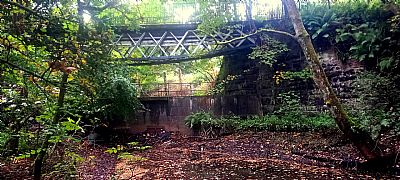VALE OF LEVEN INDUSTRIAL HERITAGE
West Dunbartonshire has a great industrial heritage to be very proud of; the principle components being shipbuilding and the textile industries, but also motor cars. These were not only vastly different in what was produced and how, but also in the social implications.
The whole of the Vale of Leven was at one time a thriving string of textile related industries that was recognised around the globe. Many of us remain proud of that heritage. But where is it now? It has all but disappeared.
If you know how to look you can find signs of the numerous textile works even though it can be a challenge. And woven in amongst all these were railways. While they were effectively independent, they were nevertheless symbiotically related. we need to see the two with this perspective.
Preserving aspects of our industrial heritage is not about returning the Vale to the past. Or of recreating a museum like environment. It is about identifying features that can be preserved as way markers of our past to point us towards our future.
Some features stand out. That of the STUCKIE BRIDGE built for the railways and the lade below it built to provide water to some of the textile works. For more about that see TEXTILE WORKS LADES and RAILWAYS
While there were certainly comparable textile industiral centres elsewhere in Britain, the industries of the Vale were quite distinctively different from elsewhere and also contrast sharply with other industries within West Dunbartonshire for instance, that of shipbuilding. Alongside the industrial developments went social change. The implications for society from a workforce with little in the way of safety and care we see it begin to benefits from altruistic efforts from their employers. We must not forget the 3 important buildings reflecting changing attitudes by authoritarian management to their workers, the school, the institute for young men and the institute for young women. But the actual industries are almost obliterated from the scene.
See : Dalmonach Works Schoolhouse; ALEXANDRIA LIBRARY : EWING GILMOUR INSTITUTE; MASONIC LODGE, ALEXANDRIA
For more on the textile works refer to the various sections on TURKEY RED & the TEXTILE INDUSTRY, OVERVIEW
Identifying key components of this industrial heritage, celebrating it and where vaiable preserving it is essential. This is what gives us our identity and acts as a datum from which to assess our future. Fortunately there is a small but excellent museum dedicated to the textile works in the Alexandria Library. But what of the few remaining physical features from this past era? Some such as the Stuckie Bridge with the lade below it that served the Croftengea and Fairfield Works remain essentially intact, practical and attractive. For more on those see TEXTILE WORKS LADES and RAILWAYS
And for the motor industry see ARGYLL MOTORWORKS, ALEXANDRIA

This picture shows the lade passing below the Stuckie Bridge. Also visible is the weir used to control the water flow.
VALE OF LEVEN PROJECT : Industry in the Vale of Leven : https://www.valeofleven.org.uk/valeindustry.html

